In their busiest season on record, the Revelation Mountains, known for their remoteness and abundance of new-routing potential, have seen first ascents by several groups. “There was a time or two in the early 1980s where there were multiple teams in the Revelations, but this is by far the most activity in one season,” Revelations guru Clint Helander explained. “This seldom-visited corner of Alaska holds only a whisper of history and still offers truly exploratory climbing,” Helander wrote in the 2013 American Alpine Journal.
The burst of activity was largely motivated by Helander’s account of the mountains in last year’s AAJ, which included a map labeling unclimbed peaks and offering secrets of virgin walls. Helander’s beta motivated several teams, including a four-man French team who summited the previously unclimbed Pyramid Peak. Following closely behind the Frenchies were Canadians Kris Irwin, Ian Welsted and Darren Vonk, who completed three new routes, including a first ascent of Dike Peak. Helander returned to the range with Graham Zimmerman for his seventh expedition, authoring the first ascent of the west face of Titanic Peak. The teams saw both failure and success, and the Revelations remain a range of enormous potential.
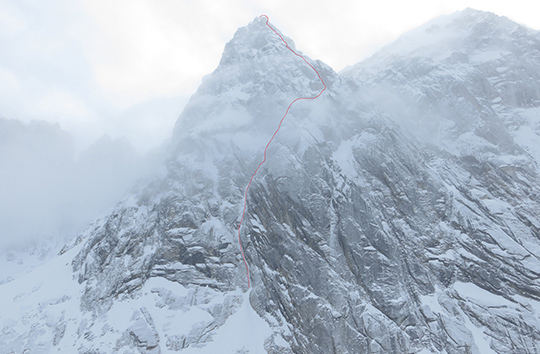
On only their second day in the Revelations, Irwin, Welsted and Vonk unwittingly established a new route up the Angel (9,265 feet). Having set out to go cragging, the three arrived at a ridge that they believed to be the summit. “[W]e realized we were on a long ridge jutting out from what seemed like one of the bigger peaks in the area,” Welsted wrote. “We overcame our initial laziness at the thought of slogging along the ridge and summited. A few days later we determined that we had summited a peak 2,000 feet higher than we had originally guessed, which took some of the pressure off the rest of the trip.” Next, they climbed Powered by Beans, completing the first ascent of Dike Peak.
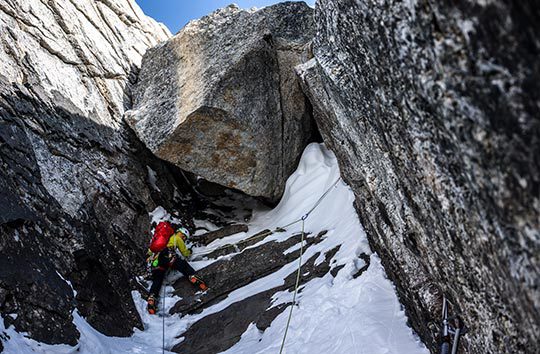
“The climb [on the Dike] went without a hitch as we had the Rockies Ice Specialist Kris Irwin to lead two thin WI5 pitches, thus opening the passage to the moderate upper mountain,” Welsted explained. “A dreamy line of single-swing neve led us to a huge gully which followed the dike the peak is named for. With two routes down, we figured we were ready for our main objective, the unclimbed central gully on Pyramid Peak whose 1500-meter face had drawn us to the range in the first place.”

While in the mountains, the group attempted to uphold a set of “casual criteria” on each climb: “less than an hour of uphill ski approach from base camp, a walking snow descent down a gully which in the Rockies would have been terrifying and a start no earlier than 10 a.m.” While attempting to climb Pyramid Peak, they were hit with light snow and spindrift in a gully ten pitches up and decided to turn around. Welsted mused afterward, “How we failed to register the risk of being in such a gully even with these spindrifts I’m not sure.”
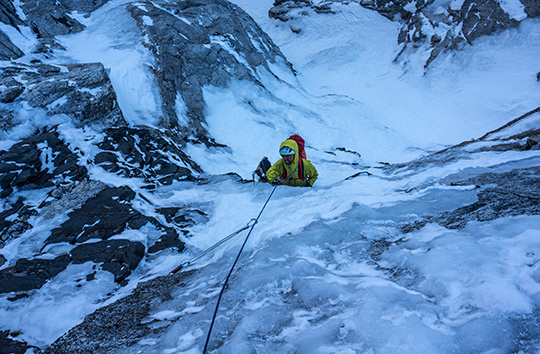
After abandoning their quest for Pyramid Peak’s summit, Irwin, Vonk and Welsted headed toward the east face of Hydra Peak (ca. 7,800 feet) for a “casual” day. “We climbed a 2,200-foot route consisting of only five pitches of technical climbing to the 7,800-foot summit,” Welsted raved. “Mind blowing thin ice climbing was interspersed with a drytooling roof or two, topped off by a spectacular ridge walk with views over to the flats on the western side of the range.” The group attempted Pyramid Peak once more, but they were thwarted again by bad conditions. “A half-hour after leaving the bottom cone of the route we saw a full-height avalanche triggered by a cornice collapse which obliterated the route.”
Despite not gaining the summit of Pyramid Peak, the three climbers left fully sated.
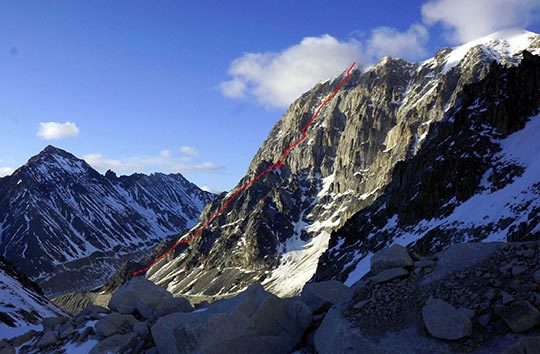
In an attempt to “mop up more projects in the area,” Helander and Zimmerman arrived in the Revelations on the coattails of the Canadians’ expedition. “On April 21st at 4:30 a.m., we set off under a gorgeous showing from the Aurora Borealis, walking 4 kilometers to the base of the route,” Zimmerman wrote. “The climb started with 1,700 feet of steep snow climbing that led us to a contact between the lower quality rock of the lower buttress and the gorgeous white granite of the upper. From here the climbing turned to high-quality mixed climbing with beautiful chimney and corner cruxes. As the sun came up, the route became drier and we rock climbed for 1,000 feet on granite that was at times impeccable and at times total choss. ”
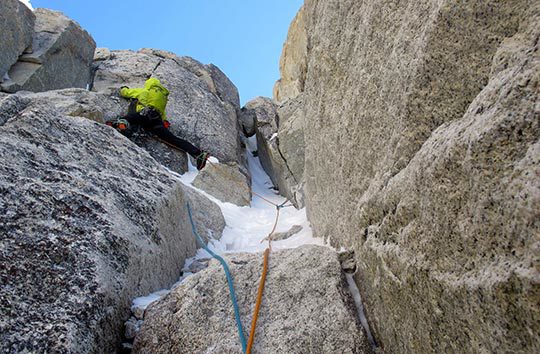
Graham Zimmerman leads mixed terrain on Titanic Peak. After summiting their new route, Helander and Zimmerman rested up before leaving to attempt another objective. During the approach however, Zimmerman fell into a hidden crevasse and badly twisted his knee, forcing a retreat.
Despite this season of increased activity, the Revelations remain an area of high potential for exploration. Upon returning from his trip, Welsted wrote that the Revelation Mountains are “a range which is sure to draw more interest from climbers and skiers in the future.”